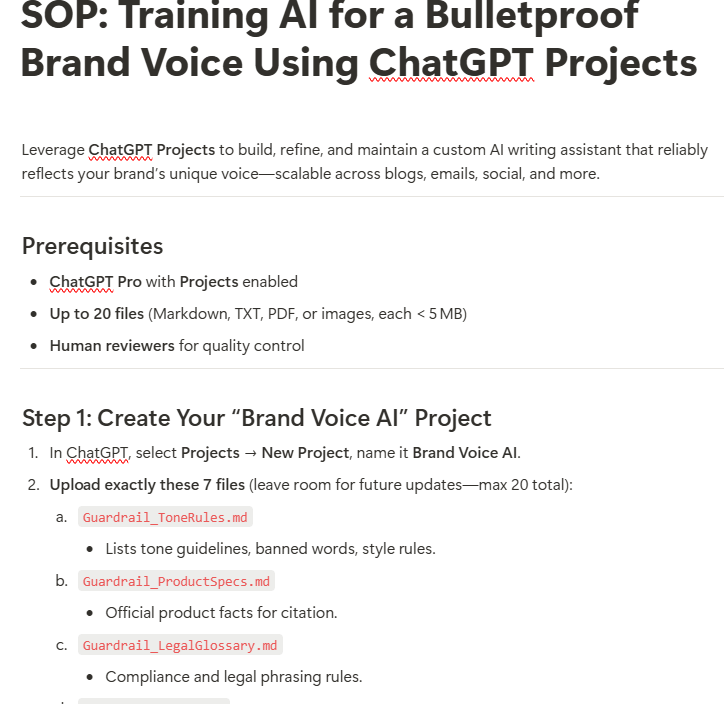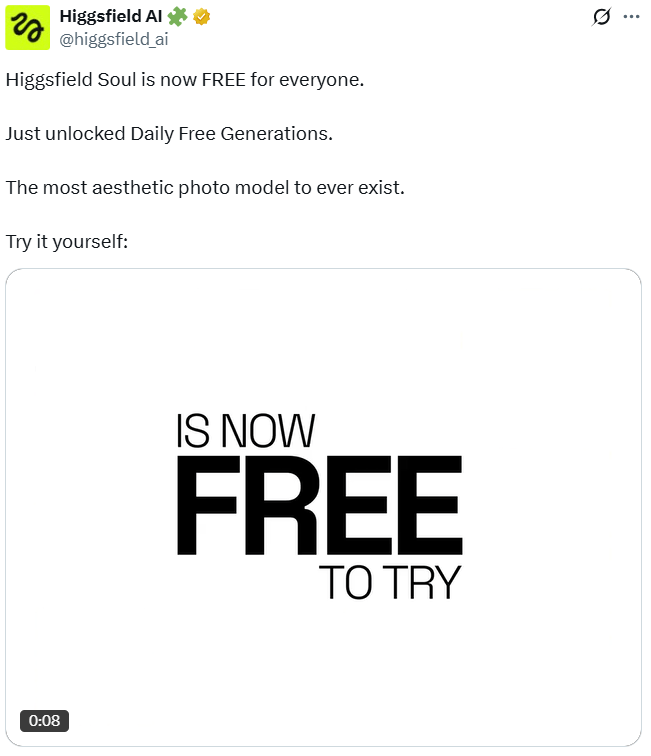- AI for Ecommerce and Amazon Sellers
- Posts
- Guide: Training AI for Consistent Brand Voice
Guide: Training AI for Consistent Brand Voice
A full SOP inside

Guide: Training AI for Consistent Brand Voice
Understanding Brand Voice AI Training
Maintaining consistent brand voice across all content—blogs, emails, social media, and marketing materials—is one of the biggest challenges for growing organizations. Traditional solutions require extensive style guides, writer training, and continuous editorial oversight, which can be resource-intensive and difficult to scale.
ChatGPT Projects offers a solution by allowing you to create a custom AI writing assistant trained specifically on your brand's voice, guidelines, and content examples. Unlike general AI writing tools, a properly configured ChatGPT Project can consistently apply your specific tone rules, product information, and style preferences across all content types.
The advantage of this approach is that it creates a scalable, consistent writing assistant that multiple team members can use while maintaining brand standards. It also reduces the need for extensive editorial review since the AI is already trained on your specific requirements and constraints.
What You'll Need
ChatGPT Pro subscription
Brand content examples - your best existing content that exemplifies your voice
Clear brand guidelines - tone rules, banned words, style preferences
Product information - accurate facts and specifications for reference
Quality control process - human reviewers to ensure output meets standards
Understanding ChatGPT Projects
ChatGPT Projects allows you to create specialized AI assistants by uploading specific files that guide the AI's behavior. You can upload up to 20 files (each under 5MB) that the AI will reference when creating content. This creates a custom knowledge base that ensures consistent, on-brand output.
Step 1: Set Up Your Brand Voice AI Project
Create Your Project Structure
Open ChatGPT and navigate to Projects
Create a new project called "Brand Voice AI"
Prepare these 7 essential files (saving room for future additions):
Core Guideline Files:
Brand_ToneRules.md- Your tone guidelines, banned words, and style rulesProduct_Facts.md- Official product information and specificationsLegal_Guidelines.md- Compliance requirements and approved phrasing
Template Files:
BlogPost_Template.md- Blog writing prompt templateEmail_Template.md- Email copywriting prompt templateQualityCheck_Template.md- Quality control checklist
Example Content:
BestContent_Examples.md- 5-10 short excerpts from your best content with annotations
Why This Structure Works
This file organization creates clear boundaries between guidelines (what to follow), templates (how to structure requests), and examples (what good output looks like).
Step 2: Create Effective Prompt Templates
Blog Post Template Example (BlogPost_Template.md):
# Blog Post Introduction Template
You are the Brand Voice AI assistant.
Write a 150-200 word blog introduction on [TOPIC].
Requirements:
- Target audience: [AUDIENCE]
- Tone: [TONE_DESCRIPTION]
- Follow all guidelines in Brand_ToneRules.md
- Use only verified facts from Product_Facts.md
- When citing product information, add "(Source: Product_Facts.md)"
- Reference the style patterns from BestContent_Examples.md
Output Format:
- Hook sentence
- Context/problem setup
- Brief solution preview
- Transition to main contentEmail Template Example (Email_Template.md):
# Email Copywriting Template
You are the Brand Voice AI assistant for email marketing.
Create an email with these components:
- Subject line options: [2 variations]
- Preheader text: [complementary to subject]
- Headline: [under 40 characters]
- Body copy: [3-5 benefit bullets]
- Call-to-action: [specific action and offer]
Requirements:
- Follow tone guidelines in Brand_ToneRules.md
- Use only facts from Product_Facts.md
- Apply style patterns from BestContent_Examples.md
- Ensure mobile-friendly formattingStep 3: Generate Content with Your Custom AI
Using Your Templates
Start a conversation within your Brand Voice AI project
Reference your template by filename and provide specific variables: Example:
Use BlogPost_Template.md to create content. Replace [TOPIC] with "5 Ways to Improve Team Productivity" Replace [AUDIENCE] with "small business managers" Replace [TONE_DESCRIPTION] with "helpful and encouraging"Add this important instruction to ensure accuracy:
Important: Only use facts from Product_Facts.md when citing product information. Do not create new facts. Always add "(Source: Product_Facts.md)" after any product claims.
Why This Approach Works
By explicitly referencing your uploaded files and providing clear variables, you ensure the AI uses your specific guidelines and examples while generating relevant content for your current needs.
Step 4: Implement Quality Control
Use Your QC Template (QualityCheck_Template.md):
# Quality Control Checklist
You are a brand compliance auditor.
Review this content and identify any issues:
1. Banned words or phrases (check against Brand_ToneRules.md)
2. Unverified product claims (must be in Product_Facts.md)
3. Tone inconsistencies (compare to Brand_ToneRules.md)
4. Style deviations (compare to BestContent_Examples.md)
5. Legal compliance issues (check against Legal_Guidelines.md)
Return only a numbered list of specific issues found.
If no issues, respond with "No issues found."Quality Control Process
Generate your content using the appropriate template
Run the QC check by pasting your draft and using the QualityCheck_Template
Fix any flagged issues and run QC again if needed
Approve for publication only after passing quality control
Step 5: Maintain and Update Your AI Assistant
Regular Updates
Monthly review of QC feedback to identify common issues
Update example content in
BestContent_Examples.mdwith new high-performing piecesRevise guidelines in your rule files as brand voice evolves
Add new templates for different content types as needed
Version Management
Use dated versions if you need to preserve older guidelines (like
Brand_ToneRules_2025-07.md)Document changes in your updates to track evolution over time
Test new versions before implementing across your team
Step 6: Scale Across Your Organization
Team Implementation
Train team members on how to use the project and templates
Establish approval workflows for different content types
Create access guidelines for who can modify templates vs. who can only use them
Set up regular training for new team members
Governance Best Practices
Assign ownership of different guideline files to appropriate team members
Schedule regular reviews to ensure guidelines stay current
Monitor output quality and adjust templates based on performance
Document processes for consistent use across your organization
Important Guidelines for Success
Content Quality
Start with great examples - your
BestContent_Examples.mdfile is crucial for teaching the AI your styleBe specific in guidelines - vague rules lead to inconsistent output
Test thoroughly - always run quality control before publishing
Iterate based on results - improve your templates based on what works
Technical Considerations
File size limits - keep each file under 5MB
File format - use Markdown (.md) for best compatibility
File organization - use clear, descriptive filenames
Update process - replace files rather than adding new versions when possible
Why This Approach Works
Using ChatGPT Projects for brand voice training is effective because:
Consistent Context: The AI always has access to your specific guidelines and examples
Scalable Process: Multiple team members can use the same trained assistant
Quality Control: Built-in checking ensures output meets your standards
Flexible Templates: Easy to adapt for different content types and needs
Continuous Improvement: Simple to update and refine based on results
Here is the full SOP here for you.
Do You Love The AI For Ecommerce Sellers Newsletter?
You can help us!
Spread the word to your colleagues or friends who you think would benefit from our weekly insights 🙂 Simply forward this issue.
In addition, we are open to sponsorships. We have more than 40,000 subscribers with 75% of our readers based in the US. To get our rate card and more info, email us at [email protected]
The Quick Read:
DuckDuckGo lets you hide AI-generated images in search results after users complained about AI clutter.
Manus shows how context engineering beats fine-tuning for agents. Their hacks to boost KV-cache, mask tools, and use the file system as memory are game-changers.
YouTube kills Trending, Meta bets everything on Reels, and LinkedIn resurfaces old posts. Platforms are aging out of virality and into relevance.
Generative AI now powers 30% of digital video ads and is set to hit 39% by 2026. Smaller brands are the fastest adopters, using AI to scale video without the price tag.
Daily free generations by Higgsfield Soul!
Modern marketing needs new roles: prompt whisperers, network navigators, and customer-side strategists. If you're not multithreaded, you're already behind.
Google's AI tools are everywhere with 2B using AI Overviews and 450M on Gemini. But investors flinched as Google ramps up spending to stay in the AI lead.
GPT-5 launches in August with smarter reasoning and new mini and nano versions. It's not AGI yet, but it might be the closest we've seen.
The Tools List:
🎨 Recraft - Create and edit graphics in a uniform brand style
📹 GPT- Transform text into lifelike and customized videos instantly
📊 Sheet Savvy AI - Use AI to save hours on repetitive tasks in Google Sheets.
💻 Brainner - Optimize talent acquisition through automated, AI-powered resume analysis.
🌊 Instant Summaries by Shortwave - Smart TL;DRs for every email.
About The Writer:

Jo Lambadjieva is an entrepreneur and AI expert in the e-commerce industry. She is the founder and CEO of Amazing Wave, an agency specializing in AI-driven solutions for e-commerce businesses. With over 13 years of experience in digital marketing, agency work, and e-commerce, Joanna has established herself as a thought leader in integrating AI technologies for business growth.
For Team and Agency AI training book an intro call here.

